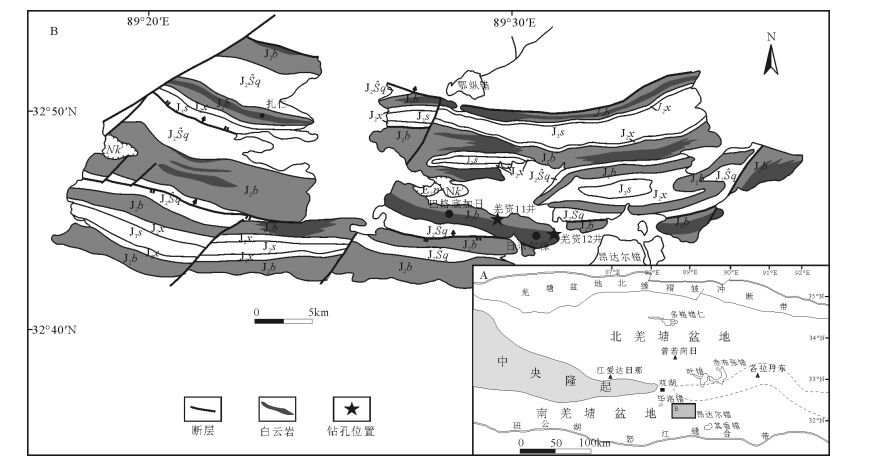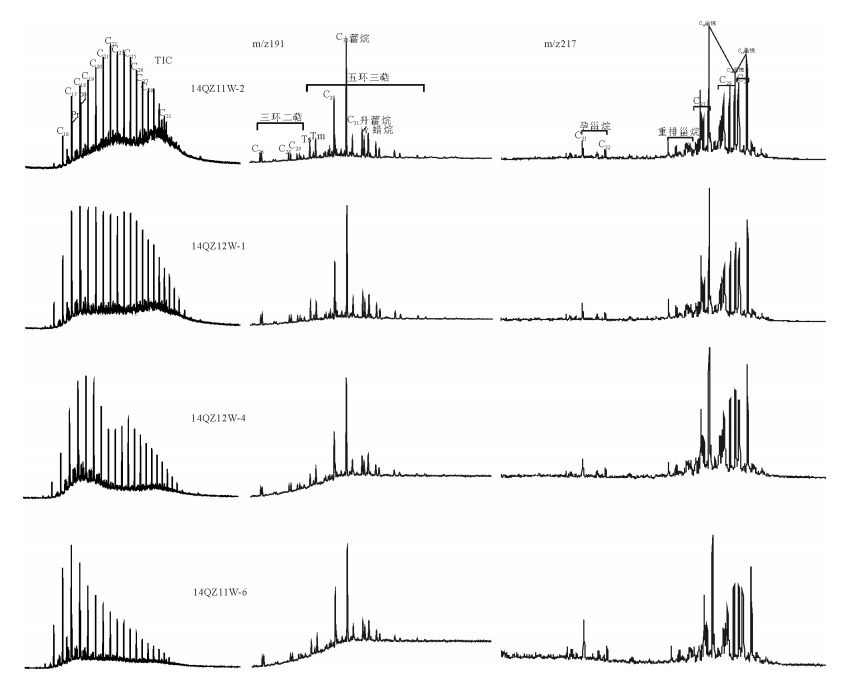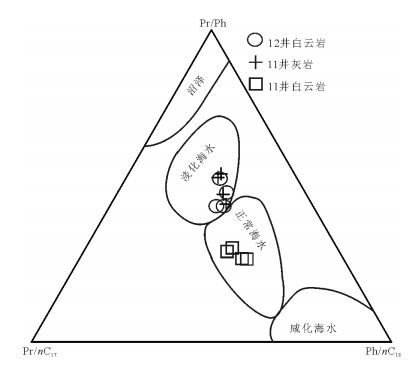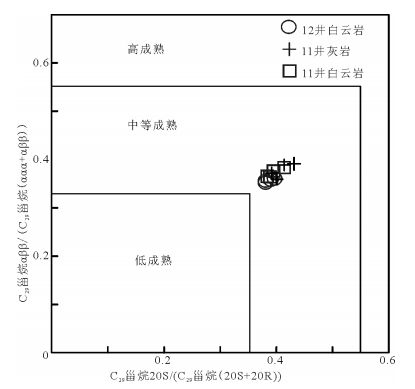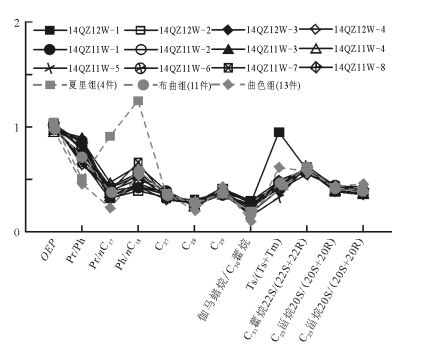Geochemical features of oil-bearing samples from the well in Buqu Formation in the Qiangtang Basin, northern Tibet, and their implications
-
摘要:
羌资11、12井是羌塘盆地揭示隆鄂尼-昂达尔错古油藏展布规律的资料井。对这2口钻井揭示的含油岩层进行取样分析,结合前人该区石油地质调查报告中羌资2井布曲组、夏里组及曲色组烃源岩的分析数据,从类异戊二烯烃、甾烷、萜烷等系列生物标志化合物参数方面进行油-岩对比研究。研究表明,羌资11、12井揭示的原油为同一种类型,但11井原油生物降解程度强于12井。各原油的母质主要来源于低等水生生物和藻类;各原油的母质形成于还原-弱还原、盐度值不高的咸水环境。原油中类异戊二烯烃、萜烷、甾烷等生物标志化合物参数与羌资2井布曲组泥晶灰岩与夏里组和曲色组烃源岩之间具有较好的亲缘性。结合南羌塘地区烃源岩有机碳资料,油源可能主要来自于曲色组,混入了部分夏里组及布曲组的油源,具有混源的特征。该研究结果对下一步油气勘探具有一定的指导意义。
Abstract:The Qiangzi-11 and 12 wells are the data well to reveal the distribution regularities of Longeni-Angdaerco palaeo-oil reservoirs. Together with the hydrocarbon source rock data of Buqu Formation, Xiali Formation, and Quse Formation from Qiangzi-2 well, the authors analyzed the oil-rock correlations based on the biomarker parameters composed of isoprenoid, steranes, and ter-panes. The property of crude oil from Qiangzi-11 and 12 wells is of the same type. However, the biodegradation degree from Qiang-zi-11 well is higher than that from Qiangzi-12. The biomarker parameters reveal that the organic matter mainly originated from al-gae. The crude oil was formed under weak reduction-reduction conditions and in a slightly salty water environment. The biomarkers of crude oil, composed of isoprenoid, terpane, and sterane, are closely related to those of the Buqu Formation in Qiangzi-2 well, and also show good correlation with those of the Xiali Formation and Quse Formation in Qiangzi-2 well. Combined with the TOC data of the hydrocarbon source rock in south Qiangtang Basin, the authors hold that the crude oil of the Longeni-Angdaerco palaeo-oil reservoir was mainly from the source rocks of Quse Formation, and partly from the Xiali and Buqu Formations, suggesting a mixture of sources. The result of this study may have some guidance significance for further oil-gas exploration.
-
Keywords:
- biomarker /
- oil-bearing dolomite /
- Buqu Formation /
- oil-rock correlation /
- Qiangtang Basin
-
大兴安岭北段具有多阶段、多构造域叠加的演化特征,从古亚洲洋构造域额尔古纳地块的演化到蒙古-鄂霍茨克构造域的影响,以及古太平洋构造域的叠加改造(图 1-a)。而大兴安岭地区出露的系列韧性变形带或变质核杂岩,是研究该地区中生代以来构造演化的窗口。
![]() 1—第四系全新统湖积;2—第四系全新统冲洪积积;3—下白垩统大磨拐河组;4—上侏罗统满克头鄂博组;5—中侏罗统塔木兰沟组;6—下侏罗统柴河组;7—下三叠统哈达陶勒盖组;8—早三叠世二长花岗岩;9—早三叠世(糜棱岩化)花岗闪长岩;10—中二叠世(压碎)细中粒二长花岗岩;11—满克头鄂博期次流纹岩;12—石英脉;13—流纹岩脉;14—流纹斑岩脉;15—花岗斑岩脉;16—花岗岩脉;17—石英闪长玢岩脉;18—闪长岩脉;19—韧性剪切带(线条疏密代表强弱);20—片理化带;21—正断层;22—地质界线;23—角度不整合界线;24—地层产状;25—流面产状;26—糜棱面理产状;27—片理(劈理)产状;28—线理产状(侧伏向、侧伏角);29—同位素测年位置及年龄值;30—剖面位置及编号Figure 1. The tectonic location (a, b), geological sketch map of the study area(c) and the polar stereographic projections of the mylinitic foliations and lineations for the XinBarag Right Banner ductile shear zone(d)
1—第四系全新统湖积;2—第四系全新统冲洪积积;3—下白垩统大磨拐河组;4—上侏罗统满克头鄂博组;5—中侏罗统塔木兰沟组;6—下侏罗统柴河组;7—下三叠统哈达陶勒盖组;8—早三叠世二长花岗岩;9—早三叠世(糜棱岩化)花岗闪长岩;10—中二叠世(压碎)细中粒二长花岗岩;11—满克头鄂博期次流纹岩;12—石英脉;13—流纹岩脉;14—流纹斑岩脉;15—花岗斑岩脉;16—花岗岩脉;17—石英闪长玢岩脉;18—闪长岩脉;19—韧性剪切带(线条疏密代表强弱);20—片理化带;21—正断层;22—地质界线;23—角度不整合界线;24—地层产状;25—流面产状;26—糜棱面理产状;27—片理(劈理)产状;28—线理产状(侧伏向、侧伏角);29—同位素测年位置及年龄值;30—剖面位置及编号Figure 1. The tectonic location (a, b), geological sketch map of the study area(c) and the polar stereographic projections of the mylinitic foliations and lineations for the XinBarag Right Banner ductile shear zone(d)目前在大兴安岭北段得尔布干成矿带已发现2条大规模韧性剪切带,一条是分布于额尔古纳河东岸的额尔古纳河韧性剪切带,另一条是分布于莫尔道嘎—佳疙瘩林场一线的佳疙瘩剪切带[1-2]。方曙等[3]将其统一归属为额尔古纳河-阿龙山NE向韧性变形域(图 1-b)。长期以来,一些学者对韧性断裂进行了初步研究,对断裂活动时代、运动学特征、构造属性认识观点不一,存在许多推测和争议,主要表现在对断裂运动学特征存在古生代的压扭性断层[4]、左行走滑韧性剪切带[2-3, 5]、先左行后右行走滑的韧性剪切带[6]、右行低角度伸展型韧性剪切带[7-10]等不同认识;对断裂形成时代存在震旦纪—印支期[6]、加里东期[11]、海西期—印支期[2-3]和晚侏罗世—早白垩世早期[7-8]、早白垩世[10]等观点。这些不同观点的提出反映研究区具体位置的差异。另一更可能的原因是,该区域韧性变形可能存在多期构造演化,具有不同的构造背景、形成时代。额尔古纳河韧性剪切带位于蒙古-鄂霍茨克缝合带附近, 是额尔古纳地块最重要的断裂带之一,对其形成时代和构造属性研究对于解释断裂与蒙古-鄂霍茨克造山带造山作用,以及确定额尔古纳地块中生代大地构造属性都具有重要的理论意义。
笔者通过内蒙古1:5万乌音呼日乐庙等四幅区域地质调查工作,在额尔古纳河韧性剪切带南部的新巴尔虎右旗地区新发现一处较大规模的韧性剪切带——新巴尔虎右旗韧性剪切带。该韧性断裂与上述前人研究的韧性断裂的关系?构造演化背景如何,与鄂霍茨克造山带造山作用关系?对前人不同认识有哪些指示意义?本文对这些问题进行探讨。
1. 区域地质背景
研究区位于大兴安岭北段西部,属于额尔古纳地块,夹持于北侧的蒙古-鄂霍茨克缝合带与头道桥-鄂伦春缝合带[1]。古生代—中新生代,依次经历了古亚洲洋构造域、蒙古-鄂霍茨克构造域和太平洋构造域的演化与多重影响[12-14],构造演化与古亚洲洋、蒙古-鄂霍茨克洋闭合密切相关[15],地质构造较复杂。
研究区发育下三叠统哈达陶勒盖组,其内发育糜棱岩及糜棱岩化岩石,其他中生代地层以侏罗系—白垩系火山岩地层为主[16],次为大面积掩盖的下白垩统大磨拐河组(图 1-c)。侵入岩发育早三叠世(糜棱岩化)花岗闪长岩、中细粒二长花岗岩及中二叠世(压碎)细中粒二长花岗岩,还发育一些次火山岩。构造以NE向深大断裂和NW向断裂为主,NE向得尔布干深大断裂带从研究区外南东部通过,是区域控岩控矿的主导因素,形成了得尔布干成矿带。
2. 新巴尔虎右旗韧性剪切带特征
2.1 野外地质特征
新巴尔虎右旗韧性剪切带分布于克鲁伦河北岸,新巴尔虎右旗西约20km处,由2条剖面控制,分别为PM1、PM2-3,出露宽度大于4 km,呈75°~90°走向延伸,倾向主体为向南倾,倾角一般较陡,部分地段有反倾(图 1-c、图 2)。该韧性剪切带向东部、西部两侧均有延伸趋势,因侏罗纪—白垩纪地层掩盖,出露范围有限,韧性剪切带内可见较连续的糜棱岩系列及碎裂岩-糜棱岩系列岩石(图 2)。
![]() 图 2 新巴尔虎右旗韧性剪切带PM1和PM2-3构造剖面(地层代号同图 1)1—碎裂细中粒二长花岗岩;2—糜棱岩化花岗闪长岩;3—细中粒二长花岗岩;4—糜棱岩带(强带);5—糜棱岩化带(弱带,线条稀疏);6—片理化带;7—砂质砾岩;8—流纹质含角砾玻屑岩屑凝灰岩;9—变质含砾不等粒长石岩屑砂岩;10—变质长石岩屑砂岩;11—变流纹质玻屑熔结凝灰岩;12—变安山岩;13—变安山质含集块角砾岩;14—阳起绿帘绿泥石化安山岩;15—石英绿帘石蚀变岩;16—变凝灰岩;17—石英脉;18—花岗斑岩脉;19—花岗岩脉;20—石英闪长玢岩脉;21—闪长岩脉;22—辉绿玢岩脉;23—地层产状;24—糜棱面理产状;25—片理(劈理)产状Figure 2. The PM1 and PM2-3 structural profiles of the XinBarag Right Banner ductile shear zone
图 2 新巴尔虎右旗韧性剪切带PM1和PM2-3构造剖面(地层代号同图 1)1—碎裂细中粒二长花岗岩;2—糜棱岩化花岗闪长岩;3—细中粒二长花岗岩;4—糜棱岩带(强带);5—糜棱岩化带(弱带,线条稀疏);6—片理化带;7—砂质砾岩;8—流纹质含角砾玻屑岩屑凝灰岩;9—变质含砾不等粒长石岩屑砂岩;10—变质长石岩屑砂岩;11—变流纹质玻屑熔结凝灰岩;12—变安山岩;13—变安山质含集块角砾岩;14—阳起绿帘绿泥石化安山岩;15—石英绿帘石蚀变岩;16—变凝灰岩;17—石英脉;18—花岗斑岩脉;19—花岗岩脉;20—石英闪长玢岩脉;21—闪长岩脉;22—辉绿玢岩脉;23—地层产状;24—糜棱面理产状;25—片理(劈理)产状Figure 2. The PM1 and PM2-3 structural profiles of the XinBarag Right Banner ductile shear zone研究区新巴尔虎右旗韧性剪切带可分解为3条韧性剪切带,编号分别为R1、R2、R3,其中R1、R2为主韧性剪切带,R3位于韧性剪切带南侧,展布局限、不完整,规模较小,与主带大体平行展布,为主韧性剪切带的次级带。多期脉岩发育,早三叠世脉岩花岗斑岩脉、流纹岩脉遭受了韧性变形改造,大多脉岩为一些晚期(侏罗纪—白垩纪)中性脉岩(闪长岩脉、石英闪长玢岩脉)、酸性脉岩(花岗岩或花岗斑岩、流纹岩脉)及石英脉,未遭受变形改造。
韧性剪切带平面上呈纵向间隔发育、走向舒缓波状延伸、强弱分带、分支复合特征(图 1-c、图 2),R1、R2主韧性剪切带表现更明显。原岩为早三叠世花岗闪长岩及下三叠统哈达陶勒盖组岩石。研究区韧性剪切带北侧及南部韧性变形减弱,局部发育片理化岩石,原岩主要为下三叠统哈达陶勒盖组变质火山岩。韧性变形带与未变形域之间无明显分界,韧性变形带表现为糜棱岩及糜棱岩化岩石,未变形域表现为碎裂岩化-正常岩石,形成透镜状或眼球状刚性体,地质图尺度,中二叠世压碎细中粒二长花岗岩即是一个整体表现为刚性的眼球状体(图 1-c、图 2),所见现象主要为压碎岩化,南侧与糜棱岩带接触边部有糜棱岩化现象,遥感影像上也能反映出其呈“眼球体”状。露头尺度也有类似宏观变形特征的写照(图版Ⅰ-a),5条强变形带间夹有弱变形域,强变形带宽度较窄,在走向上舒缓波状变化,延伸方向有分枝复合现象,矿物定向分布、塑性变形强烈,形成糜棱岩或超糜棱岩带,弱变形域夹持于强变形带间,宽度较宽,表现为碎裂岩化岩石为主,其次为糜棱岩化岩石,岩石原岩结构多有保留,与地质图(图 1-c)尺度变形特征类似。
2.2 岩石特征
发生韧性变形的地质体有早三叠世花岗闪长岩及下三叠统哈达陶勒盖组,另有少量早三叠世脉岩,剪切带走向近EW向,变形带具强弱分带性(图版Ⅰ-b),岩石的变形强弱变化在一定尺度上表现出S-C组构及不对称眼球状构造,指示变形带“上盘”(南侧)向NEE方向斜冲(图版Ⅰ-c)。
韧性变形带内由糜棱岩化岩石、糜棱岩(图版Ⅰ-d、e)、千糜岩化岩石(图版Ⅰ-f)、千糜岩组成。糜棱岩化及糜棱岩原岩主要为早三叠世岩石,岩性多为花岗闪长岩、变安山岩,少量为变流纹质含角砾岩屑凝灰岩、流纹岩(脉)、变质砾岩、变质长石岩屑砂岩。
弱变形域岩石表现为碎裂岩化-正常岩石,局部叠加有片理化。片理化岩石原岩多为变安山岩、变安山质含角砾岩屑凝灰岩等下三叠统哈达陶勒盖组岩石。不具定向组构岩石中压碎岩化岩石主要为细中粒二长花岗岩(图版Ⅰ-g、h)及部分花岗闪长岩,细中粒二长花岗岩岩体整体表现为刚性体,应属浅构造层次低温变形机制的剪切带中,组成矿物在镜下可见波状消光、机械双晶(图版Ⅰ-h)等矿物的塑性变形特征,宏观露头在该岩体边部平行于剪切带方向局部也有糜棱岩化现象(图版Ⅰ-i),构成韧性变形带的弱变形域,压碎细中粒二长花岗岩整体表现为宏观近EW向断续分布的“残斑”(图 2-a)。
该套压碎、片理化、糜棱岩系列构造岩在韧性变形带内大面积分布。糜棱岩化岩石、千糜岩化岩石、糜棱岩、千糜岩及片理化岩石、压碎岩化岩石相伴、组合发育,组成脆性、脆韧性、韧性变形的间隔发育带,形成强弱韧性变形分带及脆性、脆韧性变形分带。该套岩石是统一应力作用下,受构造层次、原岩性质、应力部位等因素影响的局部不均匀应变的结果。在中深部构造层次韧性剪切带发育,同时早三叠世,花岗闪长岩侵入定位可能比中二叠世二长花岗岩深度要深,在较深构造层次受左行斜向挤压作用韧性剪切带逐渐形成并发育,在不同深度该剪切带表现不同,花岗闪长岩表现为韧性变形及脆韧性变形;中二叠世二长花岗岩所处深度构造层次可能处于脆韧性转变以浅构造层次,主要表现为碎裂岩化,但在该岩体边部局部也有糜棱岩化现象。韧性剪切带随构造作用地质体不断抬升至稍浅构造层次,不断叠加有后期浅构造层次变形,包括碎裂岩化、片理化岩石的发育。
糜棱岩系列岩石在较高温度下受较强的应力挤压作用,矿物发生塑性变形,细粒化物质增多,基质多重结晶,石英定向拉长、波状消光,变质新生矿物与基质定向展布(图版Ⅰ-d)。
2.3 韧性剪切带运动学标志及性质
该带糜棱面理产状总体向S—SSE倾,地表局部产状具反倾现象,向N—NNW倾(图版Ⅰ-b),倾角多在50°~80°之间,个别地段略缓,达40°左右,为局部糜棱面理产状或产状变化处所致;中部及北端糜棱面理倾向175°,倾角较陡,在70°~80°之间(图 1-d),为挤压为主所致的逆断层性质。矿物拉伸线理倾伏向220°~265°,倾伏角多为40°~70°(图 1-d),根据上述产状要素结合露头尺度分析(图版Ⅰ-c),该变形带显示左行特征。由此判断,该韧性剪切带运动以逆冲为主、左行平移分量为次,运动性质为左行-逆断层。
3. SHRIMP锆石U-Pb测年
本次选取的测年样品采自韧性变形带内的糜棱岩化花岗闪长岩,样品编号为PM1-10,地理坐标为北纬48°39′56″、东经116°31′41″。样品在河北省廊坊峰泽源岩矿检测技术实验室采用常规方法进行粉碎,并用强磁选和电磁选方法进行分选,在双目镜下挑选出晶形较好,无明显裂痕和包体的锆石颗粒。锆石制靶、透射光、反射光及阴极发光图像采集、样品定年测试在中国地质科学院地质研究所北京离子探针中心完成,测试仪器为SHRIMP(Sensitive High Resolution Ion MicroProbe)仪,具体分析测试方法见宋彪等[17]。
糜棱岩化花岗闪长岩(PM1-10)锆石呈浅黄色、浅粉色、浅玫瑰色,自形-半自形四方双锥柱状、断柱状,柱面比锥面发育,部分晶棱晶面熔蚀明显,棱角模糊,呈四方双锥柱状轮廓,少呈浑圆柱状,透明,玻璃-毛玻璃光泽,高硬度。长短轴比为1~2。锆石阴极发光(CL)图像(图 3)显示,锆石具有同心环带、韵律环带,显示岩浆成因特点。Th含量为68×10-6~463×10-6,U含量为117×10-6~551×10-6,Th/U值为0.56~1.06,均大于0.4,同样指示岩浆锆石特征(图 3;表 1)。
表 1 早三叠世中细粒花岗闪长岩U-Th-Pb锆石测年数据分析结果Table 1. SHRIMP zircon U-Th-Pb isotope analyses of the Early Triassicmedium fine-grained granodiorite测点 206Pbc/% U/10-6 Th/10-6 232Th/238U 206Pb*/10-6 207Pb*/206Pb* 1σ 207Pb*/235U 1σ 206Pb*/238U 1σ errcorr 206Pb/238U年龄/Ma PM1-10-1.1 0.48 438 393 0.93 14.7 0.0478 4.5 0.256 5.7 0.0388 3.6 0.626 245.5 8.7 PM1-10-2.1 0.63 423 364 0.89 14.3 0.0456 6 0.246 7 0.0392 3.6 0.515 247.6 8.7 PM1-10-3.1 0.82 297 235 0.82 10.5 0.0447 5.4 0.251 6.5 0.0408 3.6 0.556 257.7 9.1 PM1-10-4.1 2.42 117 68 0.60 4.03 0.0421 18 0.228 19 0.0393 3.8 0.202 248.2 9.3 PM1-10-5.1 — 272 272 1.03 9.23 0.0567 4.6 0.309 5.9 0.0395 3.6 0.613 249.8 8.8 PM1-10-6.1 0.16 422 322 0.79 14.2 0.0546 5.4 0.296 6.5 0.0392 3.6 0.554 248.1 8.7 PM1-10-7.1 3.05 551 463 0.87 18.4 0.0556 7.7 0.289 8.5 0.0377 3.6 0.423 238.4 8.4 PM1-10-8.1 0.02 296 275 0.96 10 0.0508 5.5 0.276 6.6 0.0394 3.6 0.548 249.1 8.8 PM1-10-9.1 4.39 184 128 0.72 6.68 0.0466 20 0.259 20 0.0404 3.8 0.187 255.4 9.5 PM1-10-10.1 1.03 217 170 0.81 7.43 0.0499 7.1 0.272 8 0.0395 3.7 0.456 249.7 8.9 PM1-10-11.1 1.78 152 107 0.73 5.26 0.0438 20 0.239 20 0.0396 3.8 0.191 250.3 9.3 PM1-10-12.1 — 327 274 0.87 11.2 0.0511 2.5 0.281 4.4 0.04 3.6 0.824 252.7 8.9 PM1-10-13.1 1.67 292 220 0.78 9.67 0.0449 9.5 0.235 10 0.038 3.7 0.359 240.1 8.6 PM1-10-14.1 1.22 320 273 0.88 11 0.0457 9.9 0.25 11 0.0396 3.6 0.343 250.4 8.9 PM1-10-15.1 — 422 415 1.02 14.6 0.0534 2 0.297 4.1 0.0404 3.6 0.873 255.2 8.9 PM1-10-16.1 1.56 150 82 0.56 5.16 0.0447 12 0.242 12 0.0393 3.7 0.304 248.7 9.0 PM1-10-17.1 0.00 207 184 0.92 7.13 0.0538 4.2 0.297 5.5 0.04 3.6 0.655 253 9.0 PM1-10-18.1 0.19 447 426 0.98 15.5 0.0503 5.1 0.279 6.3 0.0403 3.6 0.571 254.8 9.0 PM1-10-19.1 0.38 251 238 0.98 8.41 0.0525 5.4 0.281 6.5 0.0388 3.6 0.555 245.6 8.7 共测得19颗锆石的19个点数据。在U-Pb谐和图上,这些数据点都集中分布在谐和曲线上或其附近。206Pb/238U年龄介于238.4±8.4~257.7±9.1 Ma之间,年龄加权平均值为249.3±4.1 Ma(MSWD=0.32,n=19)(图 4),表明该糜棱岩化花岗闪长岩侵位于早三叠世。
4. 讨论
4.1 形成时代
对于额尔古纳河-阿龙山NE向韧性变形域的韧性变形时代,前人做了大量研究。例如,方曙等[4]根据切割的最年轻的地质体为新元古代黑云母正长花岗岩,且被中二叠世花岗岩侵入,将该韧性变形带的变形时代推测至新元古代末期;郝立波等[3]通过穿切较新的华力西期晚期钾长花岗岩体,而未影响到小伊诺盖沟南部的燕山早期花岗岩体,确定该韧性剪切带形成于华力西晚期或印支期;张宏等[2]认为,晚古生代不具备在额尔古纳地块形成韧性剪切带的条件,从而将其形成时代限定在印支期;郑涵等[10]测得花岗质糜棱岩中黑云母40Ar/39Ar坪年龄分别为106.16±0.79 Ma和111.55±0.67 Ma,表明额尔古纳韧性剪切带是早白垩世低温隆升冷却阶段的产物;此外还存在震旦纪—印支期[6]、加里东期[11]的认识。本文测得韧性剪切带中糜棱岩化花岗闪长岩U-Pb年龄为249.3±4.1 Ma,以及发生韧性变形的哈达陶勒盖组变安山岩的SHRIMP锆石U-Pb年龄为254.3±7.9 Ma[18],剪切带南西端被中侏罗世火山岩覆盖,另外,韧性剪切带东侧下侏罗统柴河组火山岩(年龄183.8±3.9 Ma[16])及沉积岩地层未见韧性变形现象,为该韧性剪切带的韧性变形时代提供了早侏罗世下限约束。
综上,判断新巴尔虎右旗韧性剪切带形成于印支期,且限定在早三叠世之后、早侏罗世之前,为中—晚三叠世,额尔古纳河-阿龙山NE向韧性变形域可能存在晚华力西期、印支期、燕山期的变形。结合三叠纪区域构造应力场分析[4],该带为NW—SE的挤压应力所致,时代归属与本文限定的中—晚三叠世一致。本文韧性剪切带与张宏等[2]、郝立波等[3]限定的形成时代一致,为印支期,而不同于郑涵等[10]认为的早白垩世伸展型韧性剪切带。
4.2 区域对比
大兴安岭北段得尔布干成矿带已发现2条大规模的韧性剪切带,一条是分布于额尔古纳河东岸的额尔古纳河韧性剪切带,呈NE向展布,倾向W,以左行走滑为特征,另一条是分布于莫尔道嘎—佳疙瘩林场一线的佳疙瘩剪切带[2-3]。方曙等[4]将其统一归属为额尔古纳河-阿龙山NE向韧性变形域,认为该带宽5~50 km,长逾500 km,宏观上呈不规则透镜网状展布,由数条韧性变形带组成,走向主要为NEE向(或近EW向)、NE向、NNE向和NWW向。本次新发现的韧性变形带与额尔古纳河韧性剪切带南端相距约130 km,穿切了下三叠统哈达陶勒盖组变质岩及印支早期岩体,韧性剪切带走向NEE—近EW向,主体倾向S,以逆冲为主,有左行走滑分量。综合分析认为,新巴尔虎右旗韧性剪切带与额尔古纳河韧性剪切带NEE向(或近EW向)印支期性质基本一致,具有可对比性。
郑涵等[10]研究的额尔古纳断裂在不同位置产状变化较大。在室韦镇至室韦镇之南的20 km范围内,面理倾角较陡,产状主要为275°~300°∠35°~55°;在九卡-七卡之间约40 km长的剪切带中部,面理倾角变小,产状相对稳定,在实测的40余个数据中,面理产状主要分布在270°~290°∠15°~30°之间,线理产状为295°~315°∠10°~25°,表明面理主体向W或NWW方向低角度倾斜,线理向NW方向低角度倾斜。在七卡以南产状发生明显变化,面理产状变为85°~205°∠51°~65°,线理产状为250°~270°∠30°~40°;再向南被第四系覆盖。糜棱岩中还发育一组间隔的、近平行的小型剪切条带,即伸展褶劈理或C’[10],该剪切条带以小角度切割和错断透入性糜棱面理且剪切指向与糜棱岩的剪切指向一致,其研究范围较大,其中是否存在不同期次的韧性变形作用,可能需要进一步考证。新巴尔虎右旗韧性剪切带的产状特征与郑涵等[10]论述的额尔古纳河韧性剪切带七卡以南产状特征(面理产状为85°~205°∠51°~65°)相似,可能具有对比性。
额尔古纳断裂燕山期拉伸引张为主[19],形成右行伸展型韧性剪切带[7, 9-10],其至少经历了印支期和燕山期的发展演化。陈志广[19]认为其经历了海西期、印支期和燕山期3个不同发展演化阶段,其中海西期—印支期以挤压为主;郝立波等[3]认为,韧性剪切带形成于华力西晚期或印支期。新巴尔虎右旗韧性变形带能确定的是存在印支期中—晚三叠世的变形。
对于额尔古纳断裂的构造属性存在不同的认识:左行走滑韧性剪切带[2-3, 5]、先左行后右行的韧性剪切带[6]、右行伸展变形带[8]、古生代的压扭性断层[11]、右行低角度伸展型韧性剪切带[7, 9-10],本文显示左行-逆断层性质的韧性剪切带。
通过对比分析,认为额尔古纳河韧性剪切带可能属于多期构造演化、叠加的韧性剪切带,新巴尔虎右旗韧性剪切带属于额尔古纳河韧性剪切带,反映了其印支期构造形迹。
4.3 构造背景及地质意义
已有研究表明,蒙古-鄂霍次克洋三叠纪存在向南的俯冲作用,在额尔古纳地块上发育大量的早中生代花岗岩类以及斑岩型铜钼矿床为特征[19-25]。在中蒙边境Hangayn地区发育一套安第斯型大陆边缘弧火山岩,形成时代为241.3±1.5 Ma[20-21];蒙古国额尔登特的大型斑岩型铜钼矿床容矿岩体为岛弧背景下的产物,与鄂霍茨克洋的俯冲有关,其形成时代为240 Ma[22];额尔古纳地块中的太平川斑岩型铜钼矿床成矿斑岩具有埃达克岩的地球化学特征,矿床形成于蒙古-鄂霍茨克洋向额尔古纳地块俯冲陆缘弧环境,时代为202±5.7 Ma[19];八大关杂岩时代为210±2 Ma、214±2 Ma,具有活动大陆边缘弧环境的地球化学特征,应形成于蒙古-鄂霍茨克洋三叠纪晚期向额尔古纳地块南向俯冲的大地构造背景[24];研究区为发育下三叠统哈达陶勒盖组火山岩、早三叠世花岗闪长岩即为鄂霍茨克洋南向俯冲的构造背景下形成[25]。
兴蒙造山带华力西期—印支期发育多个韧性剪切带。内蒙古中部苏尼特左旗地区勃勒金韧性剪切带,形成于早二叠世早期[26];苏尼特左旗地区巴彦温都尔-乌拉音敖包对韧性剪切带为印支期的构造变形[27]。新巴尔虎右旗韧性剪切带内早三叠世的侵入-火山岩浆事件[25],以及大兴安岭地区其他早中生代花岗岩、火山岩形成于与蒙古-鄂霍茨克大洋板块俯冲有关的活动大陆边缘环境[20-21, 23, 25, 28-30],而中—晚三叠世的韧性剪切带的发育及同时代地层的大面积缺失,反映了持续俯冲、碰撞造山、隆升剥蚀作用,构造背景为蒙古-鄂霍茨克洋板块向额尔古纳地块南向俯冲的活动大陆边缘环境。在这一区域构造演化背景的作用下,形成了本区印支期的构造形迹——额尔古纳断裂,本文在其南段新厘定出这一期的构造形迹——新巴尔虎右旗韧性剪切带。中侏罗世蒙古-鄂霍茨克洋闭合之后,额尔古纳断裂的形成和发展与蒙古-鄂霍茨克洋闭合后的地幔底侵拆沉作用有关[7, 9],郑涵等[10]认为是板块碰撞后加厚的地壳在早白垩世发生伸展减薄和重力坍塌背景下的产物,与区域上晚侏罗世—早白垩世构造背景为蒙古-鄂霍茨克闭合后加厚陆壳的坍塌或拆沉的伸展环境的认识一致[30-33]。
新巴尔虎右旗韧性剪切带的厘定及时代确定,扩大了额尔古纳河-阿龙山NE向韧性变形域的范围,揭示该变形域为印支期韧性变形事件。为额尔古纳韧性变形域南部区域地质调查有启示意义,应注重在前中—晚三叠世地质体中韧性剪切带的填绘。
5. 结论
(1) 大兴安岭北段新发现一条韧性剪切带——新巴尔虎右旗韧性剪切带,运动性质为左行-逆韧性断层。
(2) 新巴尔虎右旗韧性剪切带中糜棱岩化花岗闪长岩U-Pb年龄为249.3±4.1 Ma,结合野外地质关系,变形时代归属于中—晚三叠世,为印支期晚期构造运动,构造背景为蒙古-鄂霍茨克洋板块向额尔古纳地块俯冲的活动大陆边缘环境。
(3) 新巴尔虎右旗韧性剪切带为额尔古纳河-阿龙山NE向韧性变形域的南部延伸,而后者为多期构造演化叠加作用形成的韧性变形带。
致谢: 样品分析测试得到华北油田勘探开发研究院马顺平高级工程师的大力支持,在此表示诚挚的谢意。 -
表 1 羌资11、12井样品氯仿沥青“A”及族组分含量
Table 1 The concentrations of chloroform bitumen"A"and group composition in the sample from Well Qiangzi-11 and 12
样品号 井深/m 岩性 氯仿沥青
“A”/%族组分/% 饱和烃 芳烃 非烃 沥青质 非烃+沥青质 14QZ11W-1 591 含油白云岩 0.0017 42.86 11.11 39.68 6.35 46.03 14QZ11W-2 593.95 含油白云岩 0.0004 37.52 12.48 43.75 6.25 50.00 14QZ11W-3 596.55 含油白云岩 0.0009 37.93 10.34 44.82 6.91 51.73 14QZ11W-4 598.81 含油白云岩 0.0007 30.43 13.04 47.82 8.71 56.53 14QZ12W-1 23 含油白云岩 0.0013 45.45 11.36 38.64 4.55 43.19 14QZ12W-2 34.5 含油白云岩 0.0012 46.34 17.07 31.71 4.88 36.59 14QZ12W-3 58.5 含油白云岩 0.0017 64.41 18.64 11.86 5.09 16.95 14QZ12W-4 71 含油白云岩 0.0009 65.51 17.24 10.34 6.91 17.25 14QZ11W-5 370.22 含油灰岩 0.011 46.02 34.66 14.77 4.55 19.32 14QZ11W-6 377.56 含油灰岩 0.007 46.99 31.33 18.07 3.61 21.68 14QZ11W-7 384.83 含油灰岩 0.0051 40.98 22.95 26.23 9.84 36.07 14QZ11W-8 396.78 含油灰岩 0.0024 39.58 18.75 35.42 6.25 41.67 表 2 羌资11、12井样品正构烷烃与类异戊二烯烃分析结果
Table 2 The analytical results of n-alkanes and isoprenoid alkanes in the samples from Well Qiangzi-11 and 12
样品号 井深/m 岩性 主峰碳 C21-/ C22+ Pr/Ph Pr/nC17 Ph/nC18 CPI OEP 14QZ11W-1 591 含油白云岩 nC25 0.58 0.58 0.61 0.98 1.27 1.02 14QZ11W-2 593.95 含油白云岩 nC25 0.55 0.67 0.72 0.92 1.11 0.97 14QZ11W-3 596.55 含油白云岩 nC21 1.23 0.55 0.56 0.96 1.12 0.93 14QZ11W-4 598.81 含油白云岩 nC25 0.63 0.71 0.69 0.96 1.06 0.96 14QZ12W-1 23 含油白云岩 nC25 0.61 0.74 0.42 0.53 1.04 0.97 14QZ12W-2 34.5 含油白云岩 nC18 0.68 0.78 0.32 0.39 1.04 1.03 14QZ12W-3 58.5 含油白云岩 nC18 0.74 0.68 0.31 0.43 1.02 1.01 14QZ12W-4 71 含油白云岩 nC19 0.82 0.64 0.39 0.43 1.06 1.03 14QZ11W-5 370.22 含油灰岩 nC17 1.22 0.87 0.36 0.42 1.05 1.01 14QZ11W-6 377.55 含油灰岩 nC17 1.34 0.8 0.39 0.5 1.06 1 14QZ11W-7 384.83 含油灰岩 nC17 1.52 0.9 0.34 0.43 0.97 0.97 14QZ11W-8 396.78 含油灰岩 nC17 1.69 0.87 0.47 0.63 0.98 0.95 表 3 羌资11、12井样品萜烷、甾烷分析结果
Table 3 The analytical results of terpane and sterane in the samples from Well Qiangzi-11 and 12
样品号 井深/m A B C D E F G H I 规则甾烷 C27 C28 C29 14QZ11W-1 591 0.41 0.41 0.38 0.57 0.35 0.22 0.59 0.06 0.90 0.34 0.29 0.37 14QZ11W-2 593.9 0.43 0.38 0.36 0.57 0.27 0.28 0.59 0.11 1.07 0.39 0.25 0.36 14QZ11W-3 596.6 0.43 0.39 0.37 0.57 0.27 0.28 0.60 0.10 1.00 0.37 0.26 0.37 14QZ11W-4 598.8 0.41 0.39 0.36 0.57 0.29 0.25 0.60 0.09 1.02 0.37 0.26 0.37 14QZ12W-1 23 0.95 0.38 0.36 0.55 0.27 0.30 0.59 0.12 1.12 0.40 0.25 0.36 14QZ12W-2 34.5 0.43 0.39 0.36 0.55 0.30 0.38 0.59 0.14 1.09 0.39 0.24 0.36 14QZ12W-3 58.5 0.49 0.38 0.35 0.57 0.20 0.20 0.59 0.19 1.10 0.39 0.26 0.35 14QZ12W-4 71 0.41 0.4 0.36 0.53 0.27 0.33 0.59 0.10 1.02 0.37 0.26 0.37 14QZ11W-5 370.2 0.48 0.41 0.39 0.56 0.29 0.41 0.58 0.30 1.03 0.39 0.24 0.37 14QZ11W-6 377.6 0.41 0.43 0.39 0.58 0.23 0.33 0.59 0.25 1.08 0.39 0.25 0.36 14QZ11W-7 384.8 0.46 0.39 0.37 0.57 0.23 0.48 0.60 0.43 1.00 0.38 0.24 0.38 14QZ11W-8 396.8 0.45 0.4 0.36 0.57 0.26 0.42 0.60 0.18 1.10 0.39 0.25 0.36 注:A=Ts/(Ts+Tm);B=C29甾烷20S/(20S+20R);C=C29甾烷ββ/(αα+ββ);D=C32藿烷22S/(22S+22R);E=伽马蜡烷/αβ-C30藿烷;F=三环萜烷/藿烷;G=C31升藿烷22S/(22S+22R);H=孕甾烷/C29-ααα-20R甾烷;I=ααα-20R甾烷C27/C29 -
王成善, 伊海生, 刘池洋, 等.西藏羌塘盆地古油藏发现及其意义[J].石油与天然气地质, 2004, 25(2):139-143. doi: 10.11743/ogg20040204 黄汲清, 陈炳蔚.中国及邻区特提斯海的演化[M].北京:地质出版社, 1987:36-47. 王剑, 谭富文, 李亚林, 等.青藏高原重点沉积盆地油气资源潜力分析[M].北京:地质出版社, 2004:1-88. 付修根, 廖忠礼, 刘建清, 等.南羌塘盆地扎仁地区中侏罗统布曲组沉积环境特征及其对油气地质条件的控制作用[J].中国地质, 2007, 34(4):599-605. http://www.cnki.com.cn/Article/CJFDTOTAL-DIZI200704008.htm 赵正璋, 李永铁, 叶和飞, 等.羌塘盆地南部海相侏罗系古油藏例析[J].海相油气地质, 2002, 7(3):34-36. http://www.cnki.com.cn/Article/CJFDTOTAL-HXYQ200203007.htm 陈文彬, 廖忠礼, 刘建清, 等.西藏羌塘盆地扎仁地区白云岩油苗地球化学特征[J].新疆石油地质, 2008, 29(2):214-218. http://www.cnki.com.cn/Article/CJFDTOTAL-XJSD200802026.htm 杜佰伟, 陈明, 李忠雄, 等.羌塘盆地扎仁地区中侏罗统布曲组烃源岩评价[J].新疆石油地质, 2010, 31(1):40-43. http://www.cnki.com.cn/Article/CJFDTOTAL-YQCS201203007.htm 刘建清, 杨平, 陈文彬, 等.羌塘盆地中央隆起带南侧隆额尼-昂昂达尔错布曲组古油藏白云岩特征及成因机制[J].地学前缘, 2010, 17(1):311-321. http://www.cnki.com.cn/Article/CJFDTOTAL-DXQY201001030.htm 付修根, 廖忠礼, 王剑, 等.藏北南羌塘盆地扎仁地区油苗地球化学特征及意义[J].沉积学报, 2008, 26(4):697-704. http://www.cnki.com.cn/Article/CJFDTOTAL-CJXB200804024.htm 李忠雄, 王剑, 汪正江, 等.藏北羌塘盆地羌资2井中侏罗统布曲组碳酸盐岩岩石学及储集物性特征[J].地球学报, 2009, 30(5):590-598. http://www.cnki.com.cn/Article/CJFDTOTAL-DQXB200905005.htm 李忠雄, 何江林, 杜佰伟, 等.羌塘盆地羌资2井布曲组碳酸盐岩生物标志物特征及意义[J].石油实验地质, 2010, 32(2):175-185. doi: 10.11781/sysydz201002175 和钟铧, 李才, 杨的明, 等.西藏羌塘盆地的构造沉积特征及演化[J].长春科技大学学报, 2000, 30(4):347-352. http://www.cnki.com.cn/Article/CJFDTOTAL-CCDZ200004007.htm 王剑, 丁俊, 王成善, 等.青藏高原油气资源战略选区调查与评价[M].北京:地质出版社, 2009:227-270. 丁文龙, 李超, 苏爱国, 等.西藏羌塘盆地中生界海相烃源岩综合地球化学剖面研究及有利生烃区预测[J].岩石学报, 2000, 27(3):878-896. http://www.cnki.com.cn/Article/CJFDTOTAL-YSXB201103025.htm 李忠雄, 杜佰伟, 汪正江, 等.藏北羌塘盆地中侏罗统石油地质特征[J].石油学报, 2008, 29(6):797-803. doi: 10.7623/syxb200806002 包建平, 朱翠山.生物降解作用对辽河盆地原油甾萜烷成熟度参数的影响[J].中国科学 (D辑), 2008, 38(增刊Ⅱ):38-46. http://www.cnki.com.cn/Article/CJFDTOTAL-JDXK2008S2007.htm Peters K E, Fraser T H, Amris W, et al. Geochemistry of crude oils form eastern Indonesia[J]. AAPG Bulletin, 1999, 83(12):1927-1942. http://www.academia.edu/16059123/Geochemistry_of_crude_oils_from_Eastern_Indonesia
国朋飞, 何生, 朱生奎, 等.利用三环萜烷对比泌阳凹陷生物降解油油源[J].石油实验地质, 2015, 37(1):80-87. doi: 10.11781/sysydz201501080 Peters K E, Walters C C, Moldowan J M. The biomarker guide, bio-markers and isotopes in petroleum exploration and earth history[M]. Cambridge University Press, 2005:1-704.
范璞.塔里木油气地球化学[M].北京:科学出版社, 1990. Summons R E, Volkman J K, Boreham C J. Dinosterane and other steroidal hydrocarbons of dinoflagellate origin in sediments and pe-troleum[J]. Geochimica et Cosmochimica Acta, 1987, 51(11):3075-3082. doi: 10.1016/0016-7037(87)90381-4
Volkman J K. A review of sterol markers for marine and terrige-nous organic matter[J]. Organic Geochemistry, 1986, 9(2):83-99. doi: 10.1016/0146-6380(86)90089-6
刘全有, 刘文汇, 孟仟祥, 等.塔里木盆地侏罗系煤岩热模拟生物标志化合物特征研究[J].沉积学报, 2004, 22(4):724-728. http://www.cnki.com.cn/Article/CJFDTOTAL-CJXB200404026.htm 王铁冠.生物标志物地球化学研究[M].武汉:中国地质大学出版社, 1990. 范善发, 周中毅, 潘长春, 等.塔里木盆地下古生界生物标志物分布与沉积环境的关系[J].石油与天然气地质, 1991, 12(2):169-176. doi: 10.11743/ogg19910209 段毅, 吴保祥, 张辉, 等.鄂尔多斯盆地西峰油田原油地球化学特征及成因[J].地质学报, 2006, 80(2):301-310. http://www.cnki.com.cn/Article/CJFDTOTAL-DZXE200602027.htm 聂志阳, 黄清华, 席党鹏, 等.松辽盆地松科1井烃源岩生物标志化合物特征[J].地学前缘, 2014, 21(2):265-274. http://www.cnki.com.cn/Article/CJFDTOTAL-DXQY201402023.htm Mackenzie A S, Brassell S C, Eglinton G, et al. Chemical fossilsthe geological fate of steroids[J]. Science, 1982, 217(4559):491-504. doi: 10.1126/science.217.4559.491
Moldowan J M, Albercht P, Philip R P, et al. Biological markers in sediments and petroleum[M]. New Jersey:Prentice Hall, 1992:268-280.
季长军, 伊海生, 陈志勇, 等.西藏羌塘盆地羌D2井原油类型及勘探意义[J].石油学报, 2013, 34(6):1070-1076. doi: 10.7623/syxb201306005 林金辉, 尹海生, 李勇, 等.藏北高原双湖地区中侏罗统海相油页岩生物标志化合物分布特征及其意义[J].沉积学报, 2001, 19(2):287-292. http://www.cnki.com.cn/Article/CJFDTOTAL-CJXB200102020.htm Zeng Y H, Fu X G, Zeng S Q, et al. Organic geochemical charac-teristics of the Bilong Co oil shale (China):implications for paleoen-vironment and petroleum prospects[J]. Oil Shale, 2011, 28(3):398-414. doi: 10.3176/oil.2011.3.04
陈文彬, 廖忠礼, 刘建清, 等.羌塘盆地扎仁地区中上侏罗统烃源岩生物标志物特征[J].油气地质与采收率, 2008, 15(5):17-20. http://www.cnki.com.cn/Article/CJFDTOTAL-YQCS200805007.htm 南征兵, 张艳玲, 李永铁, 等.羌塘盆地中侏罗统布曲组烃源岩评价[J].油气地质与采收率, 2012, 19(3):15-18. http://www.cnki.com.cn/Article/CJFDTOTAL-YQCS201203007.htm 伍新和, 张丽, 王成善, 等.西藏羌塘盆地中生界海相烃源岩特征[J].石油与天然气地质, 2008, 29(3):348-354. doi: 10.11743/ogg20080310 陈文彬, 廖忠礼, 刘建清, 等.西藏南羌塘盆地侏罗系烃源岩地球化学特征[J].现代地质, 2010, 24(4):654-661. http://www.cnki.com.cn/Article/CJFDTOTAL-XDDZ201004002.htm 肖睿, 祝有海, 王平康, 等.藏北羌塘盆地QK-1井中侏罗统烃源岩地球化学特征[J].现代地质, 2015, 29(1):163-170. http://www.cnki.com.cn/Article/CJFDTOTAL-XDDZ201501020.htm Fu X. G, Wang J, Chen W. B, et al. Elemental geochemistry of the early Jurassic black shales in the Qiangtang Basin, eastern Tethys:constraints for palaeoenvironment conditions[J]. Geological Journal, 2016, 51(3):443-454. doi: 10.1002/gj.v51.3
-
期刊类型引用(2)
1. 党奔,吴昌志,杨涛,姚希柱,王思梦,郑远川,顾连兴. 辽宁红透山块状硫化物矿床中矿体的变质变形特征与形成过程. 地质通报. 2021(04): 545-556 .  本站查看
本站查看
2. 申亮,赵胜金,于海洋,柳志辉,周颖帅,张猛,朴丽丽. 大兴安岭哈达陶勒盖组火山岩年龄、地球化学特征及其陆缘弧构造背景. 中国地质. 2020(04): 1041-1055 .  百度学术
百度学术
其他类型引用(1)




 下载:
下载:




